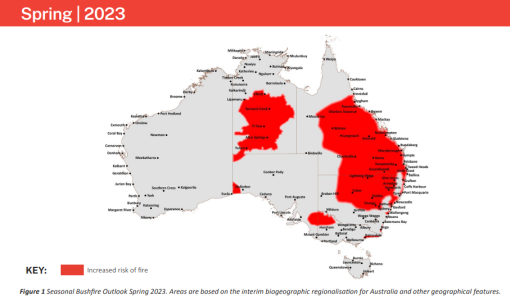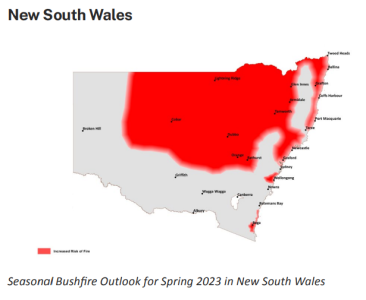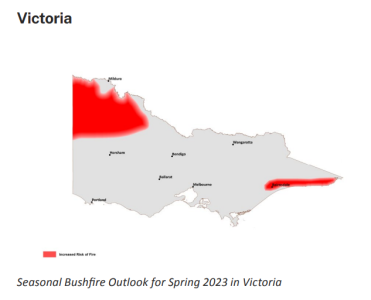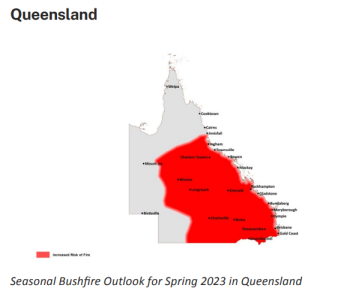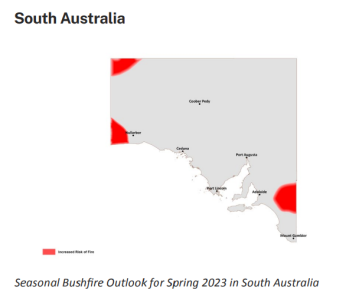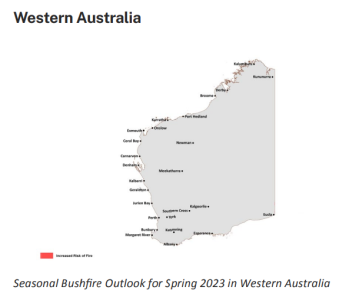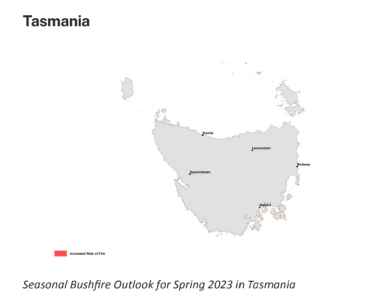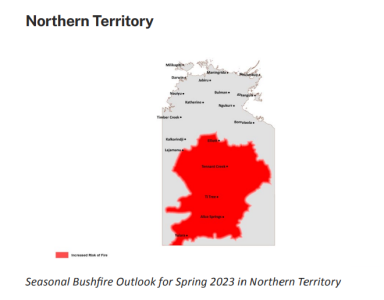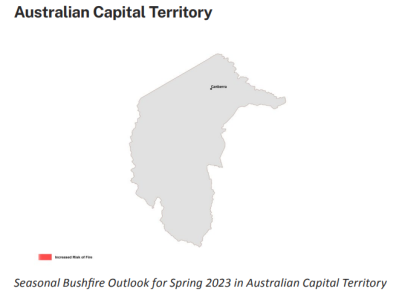Is your home at risk? Soaring bushfire dangers predicted for upcoming spring
As temperatures begin to rise again, we here at the Seniors Discount Club thought this might be an opportune time to remind you about the looming bushfire risk this spring.
Ultimately, it is important for everyone to be aware of the danger of bushfires and understand that the devastating fires seen in the past few years should never be taken lightly.
That's why we are here to share the recent news that the Australasian Fire Authorities Council (AFAC) has released its seasonal bushfire outlook for spring 2023, warning that the climate has shifted 'significantly' since last spring.
The report predicts an increased risk of bushfires for large sections of the Northern Territory, Queensland, New South Wales, Victoria and South Australia, with ‘almost the entire country [expected] to have drier and warmer conditions than normal this spring’ according to AFAC Chief Executive Officer Rob Webb.
Webb went on to explain, ‘Fire is a regular part of the Australian landscape in spring. Wherever you live, work or travel, now is the time to plan and prepare.’
He continued: ‘Understand your risk, know where you will get your information, and talk to your family about what you will do’ if an unexpected disaster strikes.
We recognise that people experience bushfires differently in various parts of the country, that's why we have rounded up the following regional information to help you stay informed.
The Bureau of Meteorology (BoM) has measured high grass and forest fuel loads in many affected areas, with some of the highest levels seen in the Sydney Basin, parts of the coast and north of the Hunter region.
To that end, hazard reduction burns (where permitted) will be undertaken as a precaution, so make sure you are aware of the latest safety practices in your local area.
A warmer and earlier start to the high-risk season is expected, and it is highly recommended that everyone makes a plan in preparation for the spring months.
You can create your own Bushfire Survival Plan using this guide here.
This is a particularly worrying development for many of the state’s vegetative regions, and residents are reminded not to ignore common fire safety practices regardless of the time of year.
This could be a potentially dangerous situation, as drier and warmer conditions may contribute to higher surface fuel availability in the late spring, which could make bushfires much harder to put out.
Average grass fuel loads and ‘adequate fire scar coverage’ across the Top End, Katherine, and Arnhem districts mean there is normal fire potential for these regions.
But high levels of grass fuel loads, high continuity of these fuels and high densities of invasive buffelgrass have all increased the risk of wildfires travelling across vast distances during spring.
Residents may also refer to Bushfires NT for fire management support in the fire protection zones.
The complete outlook is available through this link.

As mentioned, everyone needs to stay informed and prepare accordingly. We hope that everyone stays safe this spring.
Do you have additional bushfire prevention tips, members? Share them in the comments!
Ultimately, it is important for everyone to be aware of the danger of bushfires and understand that the devastating fires seen in the past few years should never be taken lightly.
That's why we are here to share the recent news that the Australasian Fire Authorities Council (AFAC) has released its seasonal bushfire outlook for spring 2023, warning that the climate has shifted 'significantly' since last spring.
The report predicts an increased risk of bushfires for large sections of the Northern Territory, Queensland, New South Wales, Victoria and South Australia, with ‘almost the entire country [expected] to have drier and warmer conditions than normal this spring’ according to AFAC Chief Executive Officer Rob Webb.
Webb went on to explain, ‘Fire is a regular part of the Australian landscape in spring. Wherever you live, work or travel, now is the time to plan and prepare.’
He continued: ‘Understand your risk, know where you will get your information, and talk to your family about what you will do’ if an unexpected disaster strikes.
We recognise that people experience bushfires differently in various parts of the country, that's why we have rounded up the following regional information to help you stay informed.
New South Wales
Members in NSW should be particularly vigilant of the fire risk this coming season, as the AFAC report identified an increased risk for large areas of Central and Northern NSW.The Bureau of Meteorology (BoM) has measured high grass and forest fuel loads in many affected areas, with some of the highest levels seen in the Sydney Basin, parts of the coast and north of the Hunter region.
To that end, hazard reduction burns (where permitted) will be undertaken as a precaution, so make sure you are aware of the latest safety practices in your local area.
Victoria
Victorians may also find themselves in for a harsher-than-usual spring, as drier conditions have set the stage for bushfires to get out of control faster than usual.A warmer and earlier start to the high-risk season is expected, and it is highly recommended that everyone makes a plan in preparation for the spring months.
You can create your own Bushfire Survival Plan using this guide here.
Queensland
The gloomy outlook has continued in Queensland, as the combination of drying fuels, forecasted below-average rainfall, and above-average temperatures is likely to set up some ‘locally intense’ bushfire activity in the near future.This is a particularly worrying development for many of the state’s vegetative regions, and residents are reminded not to ignore common fire safety practices regardless of the time of year.
South Australia
As the fire risk map continues to move south, the winds of change have also been felt in South Australia. The recorded above-average rainfall rapidly changed to below-average after the start of the season, which led to soil drying out in many areas. High fuel loads have led to increased efforts for hazard reduction throughout the entire spring before summer arrives.This could be a potentially dangerous situation, as drier and warmer conditions may contribute to higher surface fuel availability in the late spring, which could make bushfires much harder to put out.
Western Australia
Western Australia is feeling the pressure too–while winter rainfall has been below average for the south of the state, an above-average wet season in the Kimberley area has delayed curing in the savanna grassland where most of the late dry season fire risk lies.Tasmania
Tasmania is the only exception, with normal bushfire risk predicted for spring. However, with drying conditions and an abundance of fuel expected come summer, now may be the ideal time to plan for the future in case of any unanticipated developments.Northern Territory
Drying conditions are predicted across the board in the Northern Territory as El Niño continues to develop.Average grass fuel loads and ‘adequate fire scar coverage’ across the Top End, Katherine, and Arnhem districts mean there is normal fire potential for these regions.
But high levels of grass fuel loads, high continuity of these fuels and high densities of invasive buffelgrass have all increased the risk of wildfires travelling across vast distances during spring.
Residents may also refer to Bushfires NT for fire management support in the fire protection zones.
Australian Capital Territory
As it stands, a normal bushfire risk is expected for the ACT in spring. However, the fire agencies and land managers have warned that the ‘long-range outlook for spring predicts drier and warmer conditions’, which may ‘raise the possibility of increased bush and grass fire risks for summer’.The complete outlook is available through this link.
Key Takeaways
- The Australasian Fire Authorities Council (AFAC) has released its seasonal bushfire outlook and warns of an increased risk of bushfire in large parts of the country due to a shift in climate, including above-average temperatures and below-average rainfall.
- The increased rainfall in recent years has led to increased fuel growth around the country. Spring 2023 sees an increased bushfire risk for large areas of the Northern Territory, Queensland and New South Wales, as well as regions in Victoria and South Australia.
- State and territory fire authorities will continue to monitor local conditions closely and undertake bushfire mitigation activities. People are urged to plan and prepare, understand their risk, know where they will get information, and discuss their actions in case of a fire.
- Predictions for each state and territory are laid out, with various areas preparing for different risk levels and planning accordingly, including conducting hazard reduction burns, preparing fire plans and advising property owners to prepare in advance.
As mentioned, everyone needs to stay informed and prepare accordingly. We hope that everyone stays safe this spring.
Do you have additional bushfire prevention tips, members? Share them in the comments!

